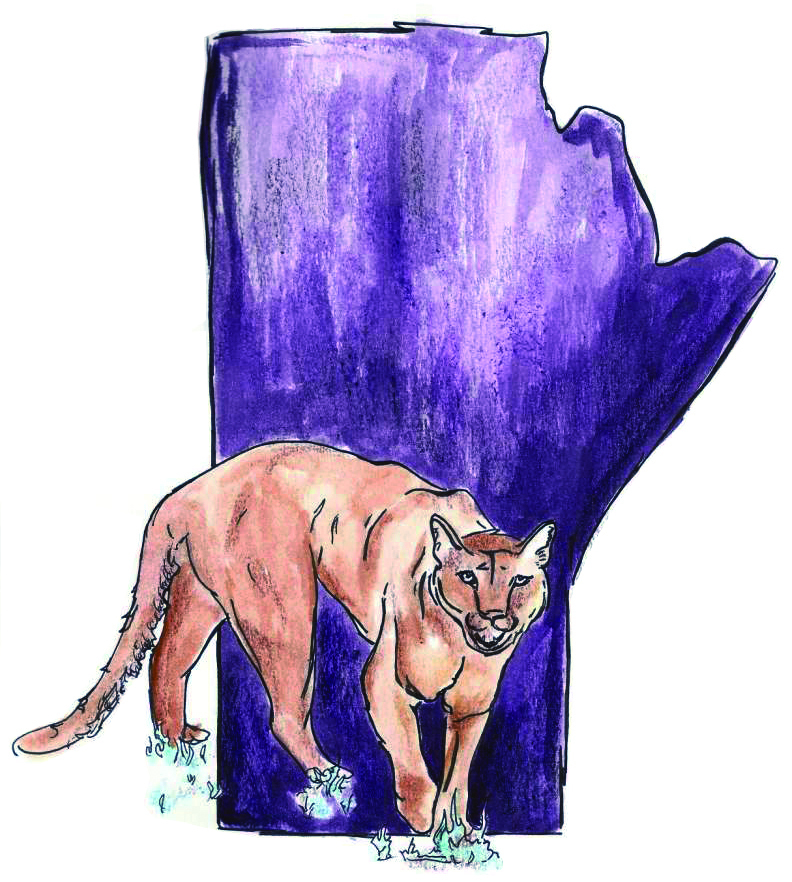Are there resident breeding populations of cougar in Manitoba? “The answer is a resounding . . . maybe,” according to Bill Watkins while presiding over a crowd of engaged university students and science professionals in attendance at The Wildlife Society’s fall mixer on Nov. 17.
Watkins is a zoologist for Manitoba Conservation and a local expert on cougars in Manitoba. Along with his involvement in various other ongoing projects with Manitoba Conservation, Watkins has spent the last 10 years profiling Manitoba’s scarce, and perhaps non-breeding, cougar population. Through a combination of eyewitness reports, historic records of observations and scant physical evidence collected in the form of droppings, tracks, fur and even the rare necropsy being performed in the event that a dead cougar is found, he is helping to put together the portrait of cougars in the province.
Active monitoring of this species’ presence in Manitoba dates back to 1973, when the first cougar in recent history was shot northeast of Winnipeg in Stead, Man. and turned in to the wildlife branch of Manitoba Conservation. Between that time and 2004, no objective evidence of cougar sign was observed in the province.
But in the short time after Watkins was appointed to the cougar-monitoring helm, two dead cougars were reported in the span of two months in late 2004. One cougar was shot by a landowner south of Duck Mountain Provincial Forest. The landowner was later fined, as the cougar was and remains provincially listed as a “protected” species. The other was caught in the power-snare of a certified trapper south of Riding Mountain National Park — the killing was deemed non-deliberative and no charges were laid.
Confirmed sightings have continued to increase in frequency since 2004. In the east, this consisted of a 2004 confirmed sighting in Hollow Water, as well as one in Lee River in 2008. “A cougar was killed in January [of 2011] near Turtle Mountain Provincial Park and another was photographed by a trail camera in October along the eastern edge of Riding Mountain National Park. In 2010, two separate sets of cougar tracks were found in southwest Manitoba in October and November,” wrote Watkins in an email to the Manitoban.
Very little has changed in the way of active cougar monitoring techniques, and while this recent rise in sightings may indicate that Manitoba’s slim cougar population is growing, studying them doesn’t appear to be much easier. According to Watkins, “Their rarity, more than anything else, makes the cougar hard to study in Manitoba. [ . . . ] As a result, nobody is doing cougar research in Manitoba at this time. Manitoba Conservation investigates sightings, takes reports, collects hair and scat samples for DNA analysis, but we are the only ones involved.”
On top of being rare in Manitoba, cougars are a very nomadic species in general. Watkins told the Manitoban that “radio collared cougars from the South Dakota population have ended up in Saskatchewan, Montana, Minnesota, Wisconsin, and Connecticut.”
“Males tend to travel farther than females, but both sexes have now been shown to disperse long distances,” Watkins added.
In order to map cougar occurrence and prevalence in the province, Manitoba Conservation relies heavily on the public — especially rural Manitobans — to communicate sightings and suspicion of cougar sign. That being said, eyewitness accounts notoriously lack credibility. Watkins noted in his Wildlife Society presentation that roughly 80 per cent of all reported sightings in the past were, upon closer inspection, later deemed unreliable.
What’s the explanation for this mass misidentification? Surely, someone would have to be rather certain of what they saw to go out of their way to contact Manitoba Conservation or the local authorities? Watkins thinks it’s related to increasing “urbanization” and “an ongoing separation from nature.”
“People just aren’t as familiar with the flora and fauna of Manitoba as their rural parents and grandparents were, and make mistakes when trying to identify an animal,” Watkins added.
Whenever a cougar spotting occurs, the conversation in the media invariably turns to the safety of people in the area. For those unduly weary of being attacked: the odds of a fatal interaction are negligible at best — less than one a year in all of North America. A cougar behaving normally is no more a threat than any other large predatory animal; this includes black bears, wolves, coyotes, etc.. For some additional context: according to Watkins, “in Canada, there were 28 fatal dog attacks on people between 1990 and 2007.”
Growing up in Manitoba, there has been a sort of mystified version of the cougar that has always grabbed me. Watkins’s informative talk at the Wildlife Society did well to fasten my sights on the truly more complex and interesting matter of Manitoba’s cougars.
illustration by lauren mcphaden


Really great article!!
Good to know there is someone interested, educated, and willing to investigate cougars, or the potential of cougars in Manitoba. These cats seen or unseen have the ability to enrich anyones life.